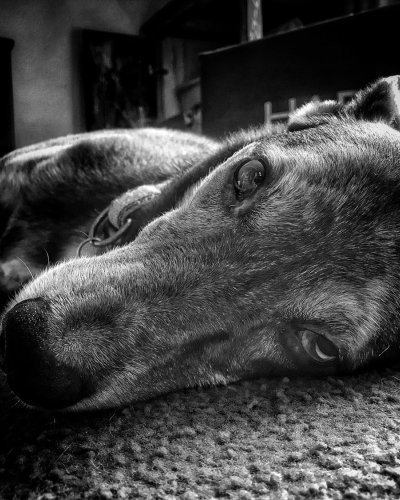Complementary and Alternative Treatments for Dogs
There is an increasing awareness that diseases don’t occur in isolation but, rather, require looking at the body as a holistic system. Imbalances in one part of the body create compensatory issues in other parts of the body. Complementary and alternative therapies are based on precisely this approach: to promote the overall well-being of our dogs.
The Difference Between Complementary and Alternative Treatments?
Although they are often used as synonyms, it's important to know the difference between complementary and alternative dog treatments.
Complementary therapies are used in conjunction with conventional treatment methods in veterinary medicine and can also be referred to as adjunctive treatments. On the other hand, alternative therapies are used instead of conventional medicine.
Whether you want to provide your dog with complementary or alternative treatment, we recommend consulting with your veterinarian first. They can provide you with a medical diagnosis, which will help guide your decisions in your path towards healing your pet. There is growing recognition within the veterinarian field that solely using medication is not a complete protocol for many issues, especially those that are painful.
Benefits of Complementary and Alternative Treatments
Complementary and alternative medicine often offer an extension to traditional medical interventions and a holistic approach that traditional veterinary medicine needs to include in its usual practices. Although the number of scientific literature dealing with alternative and complementary treatments is limited, often it is the owners themselves who see a positive change in their dogs. They are the ones who advocate that the expansion of conventional treatment methods towards a holistic approach is positive and desirable.
Making Your Pet Feel Better

Complementary medicine has proven excellent in reducing pain and, through reducing inflammatory markers, positively impacts the immune system, which is especially important for patients being treated for severe or chronic diseases. When your pet feels well, there is a greater chance it will have the strength to fight the disease. The focus of many complementary methods is on reducing stress, relaxation, and anxiety to promote a general sense of well-being.
Fewer Side Effects and Symptoms
Complementary and alternative dog therapies may reduce or eliminate side effects and symptoms. For example, hyperbaric oxygen therapy, which is the therapeutic use of oxygen in a pressurised chamber, has been shown to be effective in reducing symptoms of some diseases and can be successful in treating pain.
Manual therapies such as Canine Bowen Therapy also have few side effects and yet can have a large impact on releasing pain and stress.
Control Over Your Pet’s Well-being
The bond shared between owner and dog is sacred, and owners may sometimes feel disempowered during their dog's treatment process. Complementary and alternative canine therapies offer additional choice and a more active role for owners in the treatment and recovery of their companion animals. Honouring the sacred bond between humans and canines is always at the forefront of a canine therapist's mind.
Types of Complementary and Alternative Treatments
Many complementary and alternative treatments exist; not all are equally desirable for all health conditions. Some are more successful in treating or alleviating the symptoms of injuries, while others prove extremely useful in helping with emotional and psychological imbalances in dogs. Here, we have listed some of the most commonly used ones.
Bowen Therapy
Bowen therapy is a very gentle manual therapy that works in the interconnective tissue called the fascia with the body. Since the fascia is so vast and intrinsically connected to the nervous system, promoting the healthy movement of the fascia can have a profoundly positive effect on well-being.
This therapy is used on humans, horses, dogs and other animals and is known to relax the body and mind through gentle movements. Bowen requires minimal input from the therapist, yet with moves applied in specific locations, the body is encouraged to release tension.
As a non-manipulative soft tissue therapy, Bowen therapy can be used effectively in various circumstances without affecting medical treatment. It is the perfect adjunctive therapy for a vast number of conditions.
Hyperbaric Oxygen Therapy
During hyperbaric oxygen therapy, dogs are placed into a chamber that will gradually be pressurised with a high dose of oxygen. Treatment times and frequency can vary depending on the dog's ability to tolerate confinement in the chamber and the unusual feeling of increased pressure. However, dogs tend to relax once they have become more used to the sensation, knowing they will feel better from their treatment.
Chronic injuries can often show on thermal imaging as areas of hypothermia (coolness) because circulation in the area is reduced. However, for cells to repair and function well, they need oxygen. Hyperbaric Oxygen therapy is designed to increase oxygen flowing around the body, improving circulation, reducing pain and promoting self-healing.
Acupuncture for Dogs
Contrary to expectations, this ancient therapy is very often well received by animals because it provides immediate relief.
Acupuncture is one of the five branches of traditional Chinese medicine known for over 5,000 years. It is based on the principle of harmonious energy circulation through the body, and by addressing energy at selected points, we can influence the animal's general well-being. More than 300 points have been recognised in animals, which provoke certain areas in their bodies during acupuncture treatment. The therapists use needling, heat, lasers, electric currents and sometimes injections on these well-chosen points.
The therapeutic advantages of this therapy have been particularly demonstrated in dermatology, geriatrics, organ strengthening (liver, kidney, etc.), and osteoarticular pathology.
In addition to healing and soothing, acupuncture is designed to stimulate nervous reflexes that provoke the functioning of the organs and the body to work at its full potential.
Physiotherapy for Dogs
Physiotherapy is a regulated modality of complimantary medicine within Australia, that requires extensive study. It is gaining more and more importance in veterinary clinics and is becoming a frequent supplement to classic clinical treatments. It's particularly effective in the treatment of neurological and orthopedic disorders in dogs; and for alleviating pain in old dogs and those suffering from arthritis for whom surgery is too risky. Even when surgery has been performed, physiotherapy is used as a post-operative treatment to help the animal recover faster.
Physiotherapy includes manual and instrumental techniques to diagnose and treat disorders and injuries. The basis of physiotherapy is massage and stretching, i.e. passive kinesiotherapy (joint mobilization) and active kinesiotherapy (exercises for balance, proprioception or targeted muscle building), and the use of electrotherapy, ultrasounds, hydrotherapy (walking in water which enables muscular movement without putting weight on the joints) and therapeutic laser. The initial goal of the therapy is to relieve the pain and help the animal regain its fitness. Gentle hand manipulation and natural elements such as water, light, healing/cooling methods, vibrations, etc. do wonders.
Homeopathy for Dogs
The essence of homeopathy is that it focuses on treating through a like-with-like approach. Homeopathic treatment consists of promoting dogs' health using remedies derived from natural substances. The goal of homeopathy is to stimulate the body to heal itself.
Aromatherapy for Dogs

Aromatherapy treatments use extracts of aromatic plants (essences and essential oils), which differs from phytotherapy, which uses all plant elements.
Essential oils are a concentration of active ingredients derived from the distillation of an aromatic plant. They increase resistance to illness, improve immune defences and prevent infections and contagions.
When talking to an aromatherapy specialist, mention if your dog has any allergies, as using the wrong plant essences could worsen the condition.
Aromatherapy is used in three forms: diffusion into the air, through friction, or by internal absorption.
Sound (Music) Therapy for Dogs

Sound therapy uses soothing sounds and music to improve the health and well-being of animals. It was discovered that there are specific qualities in certain musical arrangements that can calm an animal and reduce anxiety. These are compositions with long, sustained notes, consistent rhythm, less instrumental complexity, and slower tempo. Repetitive and gentle sounds have a relaxing effect on the entire nervous system.
The music sends sound waves (vibrations) that your dog's brain processes and responds to the stimulus with various physiological changes.
Music therapy can be easily implemented in our homes, and it is becoming increasingly common in veterinary clinics. Many dogs who have lived in noisy dog shelters and who struggle with anxiety respond particularly well to sound therapy.
Naturopathy for Dogs
Another therapy that focuses on a holistic approach to healing and looks at the body as a whole without singling out a single "sick" part is naturopathy.
The neuropathy will probably approach a dog's treatment with an overall health check while considering its diet and mental health before designing the therapy. Neuropathic treatment uses plants, flowers, aromatic essences, homeopathic natural remedies and trace elements. All preparations used are 100% natural and non-invasive.
It is a complementary therapy to usual veterinary practices, but the effects are often slow and require long-term treatment. Therefore, in emergency cases, as with any alternative methods, preference should be given to traditional medicine.
Osteopathy for Dogs
Osteopathy is a complementary medicine focusing on manual techniques and treating the body as a whole system comprised of interconnected systems. Based on a founding theory that, proper biomechanics and alignment of the body leads to the optimal flow of bodily fluids, which promotes the body's own capability for self-healing.
Animal Osteopathy is not regulated in Australia. However, it is essential to note that Osteopathy for humans is, and the term 'Osteopath' is a protected title for those qualified to treat human patients. Regardless of patient, canine or human, this modality understands that if one part of the body is out of balance, it will also disrupt the balance in other regions. Therefore, taking an approach that is not holistic will not yield long-lasting and quality results. Osteopathy seeks the cause of the disease, not treating only the symptoms, to penetrate the core and prevent its recurrence.
Owners can learn more about this holistic approach to treating dysfunctions within the dog's body and mind through Canine Body Balance.
Are Complementary and Alternative Treatments Risky for Dogs?

If they are carried out by an experienced and professional practitioner, complementary or alternative therapies are generally regarded as safe. It is always important to communicate in detail your dog's health (physical, emotional, mental) picture so that the specialist you are working with can better assess the type of treatment that will be most beneficial.
Consultation with your veterinarian before going to complementary or alternative therapy is important. However, when it comes to your dog's severe and urgent health condition, keep in mind that alternative medicine often requires more time to start showing results. Therefore, in such emergencies, take your dog to the veterinary clinic, and then you can gradually introduce other, less invasive treatment methods.





Leave a comment